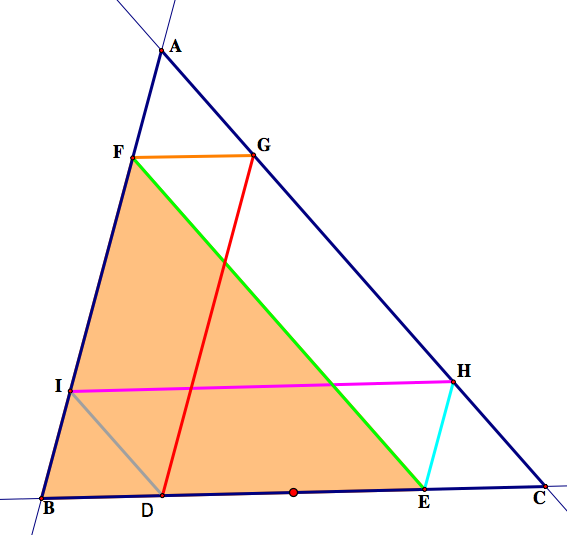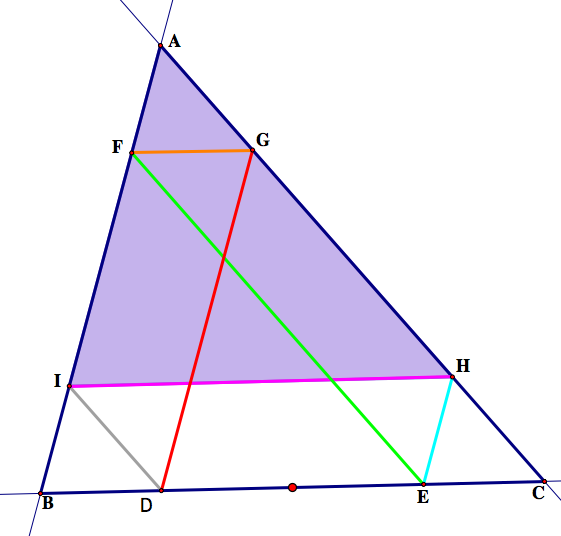

Bouncing Barney
By: Russell Lawless
Barney is in a triangular room. He walks from a point on BC parallel to AB. When he reaches AC, he turns and walks parallel to BC. When he reaches AB, he turns and walks parallel to AC. He does this continually until he reaches his starting point. The red line is the first walking pathway, the orange line is the second walking pathway, the green line is the third walking pathway, the blue line is the fourth walking pathway, the pink line is the fifth walking pathway, and the grey line is the sixth walking pathway.

So when Barney is starting at a point Start that lies on BC, he will reach the wall 5 times with 6 different walking pathways before returning back to his original spot (this does not include the last wall being his original spot). However, there are two special cases that we need to consider: the vertices B and C as well as the midpoint of BC. In both of these cases Barney hits the wall 2 times with 2 different walking pathways.
First let's look at the midpoint of segment BC. What do you notice? When we start at the midpoint of BC, the walking pathways of Barney forms the medial triangle of ΔABC. You can check this by creating the midpoints of AB and AC. Also by the mid segment theorem we can say that the orange side is half the length of BC, the red side is half the length of AB, and the green side is half the length of AC.

Now let's look at the vertex B. What do you notice? The walking pathways of Barney now trace the segments of ΔABC. So he still hits 2 walls before coming back to his original spot. If we started at vertex C instead of vertex B we would be tracing the triangle in the opposite way meaning that Barney will walk along the segment AC, then segment AB, and then segment BC back to his original spot.

That covers Barney starting within the triangle. What happens when he starts outside of the triangle?? We see that Barney will still hit 5 walls before returning back to his original spot.

So we have shown that Barney has returned to his spot when he starts from the midpoint of BC, anywhere on segment BC, the vertices B and C, and outside ΔABC while on the line BC. This should prove that Barney will always return to his starting point, right? Wrong.
Proof that Barney always returns home
Let's retrace our steps on how Barney's walking pattern is. He starts at point D and walks parallel to line AB to point G. From point G he walks parallel to line BC to point F. From point F he walks parallel to line AC to point E. From point E he walks parallel to line AB to point H. From point H he walks parallel to line BC to point I. From point I he walks parallel to line AC to point D. At this point he has returned back to his original starting place.

By using the property of parallelograms where opposite angles are congruent, we know that ∠B ≅ ∠DGF and ∠C ≅ ∠GFE. We also know that ∠B ≅ ∠GDC and ∠C ≅ ∠FEB by properties of transervals. Through other properties of parallelograms and transversals we see that GD ≅ EF. So by the property of parallelograms where opposite sides are congruent FB ≅ GD ≅ EF ≅ GC.

The same reasoning can be used for the rest of the parallelograms. There are six different congruent parallelograms that are formed by the six different pathways. Here are the following parallelograms:
IDCH ≅ AFEH ≅ AGDI ≅ FGCE ≅ IBEH ≅ BDGF






Now that we have proven those, we can focus on showing where triangles are congruent. Earlier we proved that ∠B ≅ ∠GDC, ∠C ≅ ∠FEB, ∠B ≅ ∠DGF, ∠C ≅ ∠GFE, and segments FB ≅ GD ≅ EF ≅ GC. So by AAS, we see that ΔBFE ≅ ΔDGC.

The same reasoning can be used for the rest of the congruent triangles. There are 3 different congruent triangles that are formed by the six different pathways. Here are the following triangles:
ΔFBE ≅ ΔGDC ≅ ΔAIH



Because of the reasoning above we consider this proved. However, the exceptions are when Barney starts at the midpoint of BC or at the vertices B or C. We have already explored this situation so there will be no need in checking it again.
Will Barney always travel the same distance?
See for yourself: Barney Travel
The only time that Barney will travel the same distance is when he is confined to be inside ΔABC. Once he leaves ΔABC, the distance traveled steadly increases. I observed that the perimeter of the triangle and the distance traveled by Barney while he starts inside ΔABC have equal distances. I believe that this has something to do with the parallelogram proof that was discussed above.

I also observed that the following equations work when calculating length (only for cases when the starting point is within ΔABC):
StartG + HE = AB
FG + HI = j
IStart + FE = AC
I feel that this has something to do with the parallelograms as well.
Similar and Congruent Triangles
GSP: Exploring Similar Triangles
While exploring I found that ΔAIH ~ ΔAFG ~ ΔABC. This is due to all three of these triangles having the same angles. We know that similar triangles have the same angles. This happens because ΔABC is cut by the transversals IH and FG to form ΔAIH and ΔAFG. What is neat about this is that they are always similar no matter the location of where Barney starts (inside, outside, vertices, midpoint).

Using the same exploration, we can use the reasoning in the previous problem and say that ΔBID ~ ΔBEF ~ ΔABC. We can also say that ΔCEH ~ ΔCDG ~ ΔABC. So because all the triangles that were listed above are similar to ΔABC, we can also say that they are similar to each other. So ΔABC ~ ΔBID ~ ΔBEF ~ ΔAIH ~ ΔAFG ~ ΔCEH ~ ΔCDG.


Using the same reasoning as we did when we proved that the triangles were congruent by using the properties of a parallelogram, we can conclude that the intersection of pathway 1, 3, and 5 intersect at the same point is the centroid of ΔABC and creates 9 congruent triangles.

If you want to do some exploring on what happens when Barney does not start on a segment of ΔABC then click the following GSP file: Barney is loose.